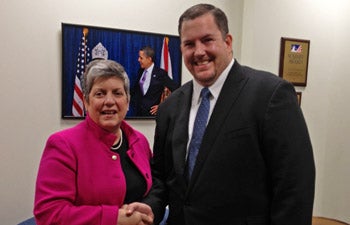Mark Benthien Honored by the White House
The 6.7-magnitude Northridge earthquake that shook Southern California in 1994 did more than rattle Mark Benthien out of his bed at UCLA. It reaffirmed his commitment to earthquake preparedness.
After that quake, which killed 57 people and injured 8,700 others, the applied geophysics major was responsible for placing seismometers in people’s backyards to record aftershocks.
Talking to residents about their earthquake fears, Benthien decided to dedicate his career to helping save lives by increasing the public’s understanding of earthquake risk. Two years later he was hired to support education and outreach activities at the Southern California Earthquake Center (SCEC) headquartered in USC Dornsife.
“When I was in high school I thought I needed to be a seismologist and predict earthquakes in order to help Californians be safe,” said Benthien, now SCEC’s director for communication, education and outreach, and executive director of the Earthquake Country Alliance (ECA) also based in USC Dornsife. “But in my work at UCLA I saw that there was a place for me in helping to communicate crucial information.” Much of this work was on joint projects coordinated by SCEC, of which UCLA is a core institution.
Benthien’s work preparing California communities and beyond for earthquakes — including promoting the “Drop, Cover and Hold On!” self-protection procedure as part of the Great California ShakeOut annual earthquake drill— has been recognized by the Federal Emergency Management Agency (FEMA) and the President Barack Obama administration. Benthien was among 17 leaders honored as a Champion of Change at the White House in Washington, D.C., Jan. 19. All were honored for their efforts to increase public awareness in disaster preparedness.
“Being selected as a White House Champion of Change is a recognition of the success of many people brought together by SCEC over the past 10 years to deepen our partnership, create products and programs and motivate preparedness,” Benthien said. “I’m honored to lead the ECA and work with so many excellent people and partners.”
The White House Champion of Change program recognizes citizens of all ages and walks of life for their exemplary work improving their communities. In Washington, D.C., Benthien joined fellow honorees in a discussion about how to best engage communities in emergency preparedness.
“This past year we’ve been reminded that disasters can strike at any time and that preparedness is critical,” said Secretary of Homeland Security Janet Napolitano, referring to the May 2011 tornadoes that ripped through Arkansas, Kansas and Oklahoma and Hurricane Irene that devastated the Caribbean and parts of Canada and the United States including North Carolina in August 2011.
“We commend the innovative practices and achievements that these individuals bring to the field of emergency management in order to make our communities safer, stronger and better prepared,” Napolitano said.
Benthien joined SCEC in 1996 and developed ECA in 2003. Funded by the National Science Foundation and the U.S. Geological Survey, SCEC is a center that partners with more than 600 scientists and more than 60 institutions worldwide to research and develop earthquake forecasts.

Secretary of Homeland Security Janet Napolitano recently recognized USC Dornsife’s Mark Benthien for his efforts to increase public awareness in disaster preparedness during the White House’s Champion of Change recognition ceremony at the White House in Washington, D.C., Jan. 19. Photo courtesy of Mark Benthien.
ECA is comprised of organizations partnering with SCEC to provide earthquake information and services to communities throughout the world. Through the alliance, Benthien in 2008 helped develop the Great California ShakeOut for which he serves as lead organizer. More than 8.6 million people participated in the earthquake drill statewide in 2011. The 2012 ShakeOut is being planned for Oct. 18.
“The ShakeOut has really become an infrastructure for organizing communities to act for preparedness,” Benthien said. “It’s making sure people know how to protect themselves and come together.”
In developing the ShakeOut drill, Benthien drew on social science research findings that people are most likely to prepare for emergencies once they know their neighbors are doing so.
“We wanted to include as many types of participants as possible,” Benthien said. “We invited not only emergency managers, but scientists, engineers and residents. We worked hard to make sure that everyone could see their place in such an activity and that it included a big exercise.”
In addition to the California ShakeOut, Benthien and SCEC web developer John Marquis, along with an “army” of USC students, manage ShakeOut Web sites for drills now held or planned across the country and internationally (see www.shakeout.org/regions). For example, on Feb. 7, the second Central U.S. ShakeOut involved 2.4 million participants from nine states, and SCEC is now developing the web site for the New Zealand ShakeOut in September 2012 and consulting with a group planning the first Tokyo ShakeOut in March.
“USC is a fantastic home for the ShakeOut,” Benthien said. “As a private university we are able to do things that government agencies usually cannot, such as listing participants who have registered–a key feature of the ShakeOut Web sites that encourages others to sign up. Being based in an academic environment also maintains our focus on incorporating research findings from earthquake science and engineering as well as the social sciences.”
During a roundtable discussion in Washington, D.C., Richard Serino, deputy administrator of FEMA asked what the agency could do to help further the cause of emergency management and preparedness. Benthien recommended that FEMA strengthen its Whole Community approach by incorporating research that supports the plan. The Whole Community approach recognizes that it takes all aspects of a community to effectively prepare for, protect against, respond to, recover from, and mitigate against any disaster. The program engages families, individuals and organizations in emergency management.
Watch the Jan. 19 Champion of Change panel discussion at the White House in Washington, D.C., on YouTube.